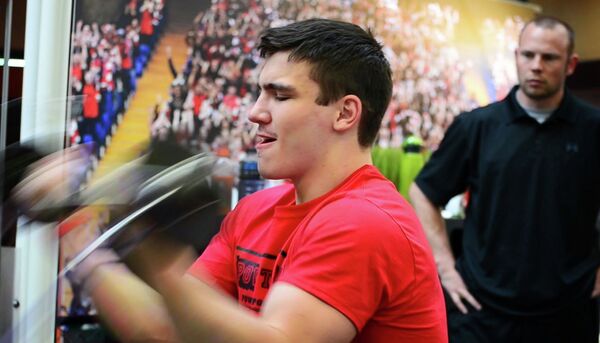MANHEIM, May 22 (by Karin Zeitvogel for RIA Novosti) – In this quiet Pennsylvania town in the heart of Amish country, where life moves at a pace from bygone times, Russia’s Lokomotiv Yaroslavl ice hockey team has set its sights squarely on the future, looking to move beyond a past marred by tragedy.
Nearly two years after losing almost all its players and coaches in a plane crash, Lokomotiv Yaroslavl sent 18 young players across the Atlantic Ocean to the US East Coast to be put through a grueling six-week regimen by American training coach Steve Saunders.
The Lokomotiv players show up every weekday morning for strength training at the red-brick building housing the gym, then go back to their hotel for a catered lunch, which ensures that they eat healthy, nutritious fare and aren’t tempted by American fast food.
(Watch the video report, below.)
In the afternoon, the workouts focus on endurance, and every once in a while Saunders will throw in an evening session, saying “It depends on how mean I’m feeling.”
Egor Yakovlev, who in October 2011 became the first player to sign with Lokomotiv after the Sept. 7, 2011 plane crash that claimed the lives of 37 players, coaches and support staff, and seven crew members of the plane that was supposed to carry them to the first game of the Kontinental Hockey League (KHL) season in Belarus, said he was keen to put Saunders’ training method to the test.
“I’d seen videos about what people are doing here. I wanted to try it,” Yakovlev told RIA Novosti, adding that Saunders’ workouts, which involve no ice-time and lots of upper body training, are “unusual” for a hockey player.
“It’s also a great chance to visit the United States,” the 21-year-old said, saying he likes the way “everything works and people obey the law” in America.
The statement is benign at first glance but weighty with meaning when you know what Russian investigators have said caused what hockey fans call the “Lokomotiv crash.”
The team’s Yak-42 plane slammed into the banks of the Volga River on takeoff because of pilot error and a failure on the part of the plane's owner to observe safety standards and adequately train its pilots, Russian investigators said.
The probe into the crash also found that one of the pilots on the doomed flight was taking phenobarbital, a medication to control seizures, which is prohibited for use by pilots.
Yaroslavl, a city of some 700,000 people nestled at the confluence of the Volga and Kotorsol Rivers, had its soul ripped out by the crash. The city “loves hockey and lives for hockey, filling the stadium with 9,000 people for every game,” Lokomotiv assistant coach Nikolai Borschevski told RIA Novosti.
But he refused to talk about the crash, and asked that the players not speak about it either.
“We’re here to look forward, to get strong,” he said.
After the plane crash, the three-time Kontinental League champions pulled out of the KHL for the 2011-12 season, but rejoined the following year.
Half the players training in Manheim played for Lokomotiv in the KHL’s 2012-13 season, and half are first-time recruits to the team.
They arrived in the United States in mid-April, stopping in New York City first.
“I heard them talking in Russian, and I could tell they were talking about New York,” Saunders said.
“About 15 minutes into the three-hour drive to Manheim, I said to them, ‘Where you’re going doesn’t look like this.’ And the one guy who spoke a little English looked at me, a bit perplexed, and said, ‘What does it look like?’
“I said to him, ‘farms.’”

Indeed, Manheim is such a sleepy little town that on the day that RIA Novosti visited, the top radio news stories in town were about a kid getting kicked by a pony and how to make money at yard sales.
The town of 5,000 people – just over half the number who go to Lokomotiv games in Yaroslavl – is surrounded by fields, grazing cattle and barns.
Outside a home in the hills overlooking Manheim, a resident was selling hand-painted bluebird houses. A young woman in 19th-century Amish-style dress ploughed a field from the back of a donkey-drawn tractor in the valley below.
Compared to life in a Russian city, Manheim is “slow-paced, no one’s in a hurry, and there is nothing to distract you” said Borschevski.
The relaxed pace – when Saunders isn’t barking at the players to bench press 200 pounds (90 kilograms) one last time or to sprint up the bleachers for a final set – and lack of distractions are ideal for training.
In the five weeks they have been in Manheim, many of the players have developed six-pack abs, pectorals and biceps that look like the legendary movie boxing champion Rocky Balboa.
They’ve also built on nonexistent English to fluency in the vocabulary of the fitness world as they do their daily training, especially, as player Yaroslav Gavrikov said, the words “rest, relax, last one” – music to a hockey player’s ears.

